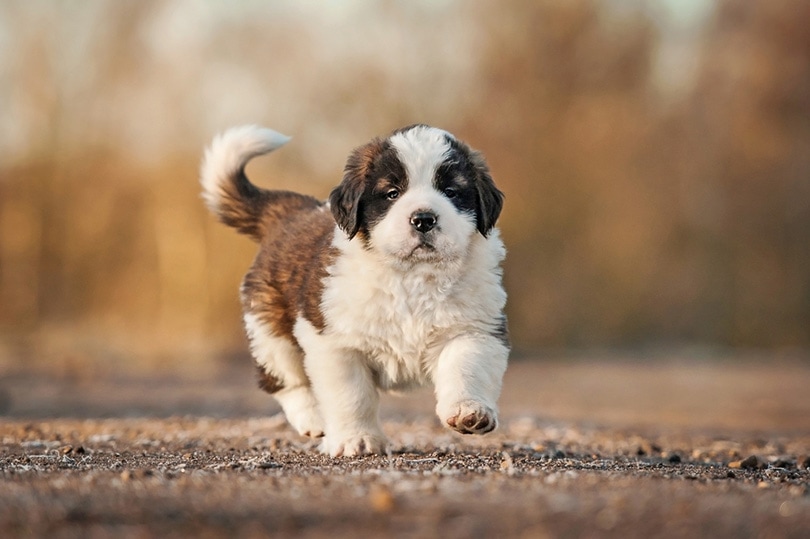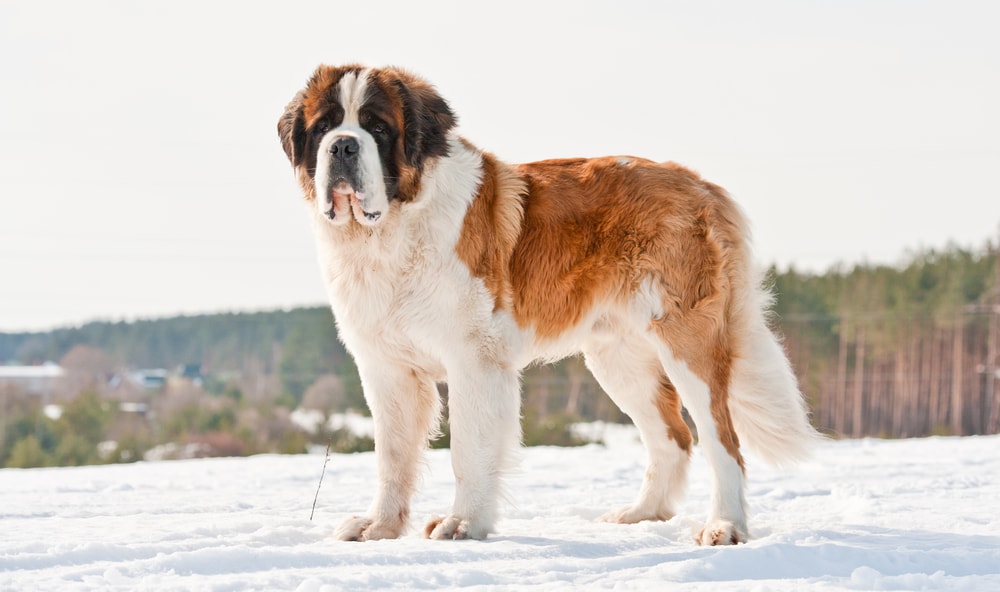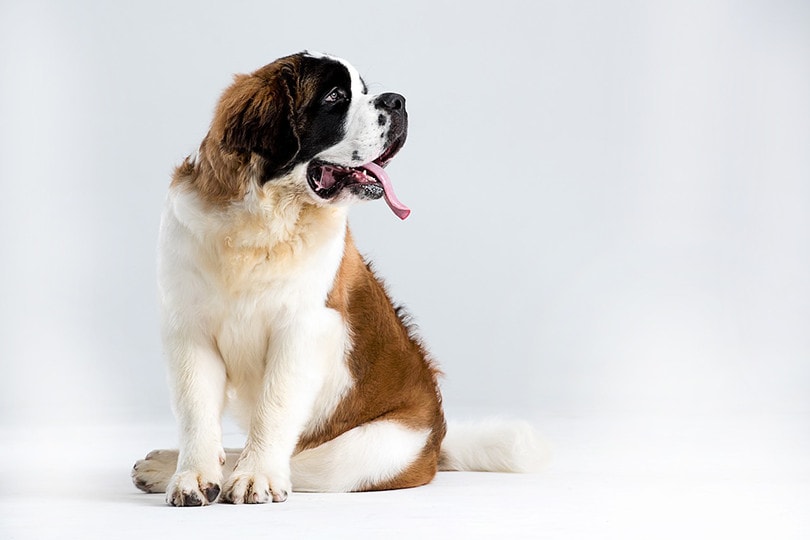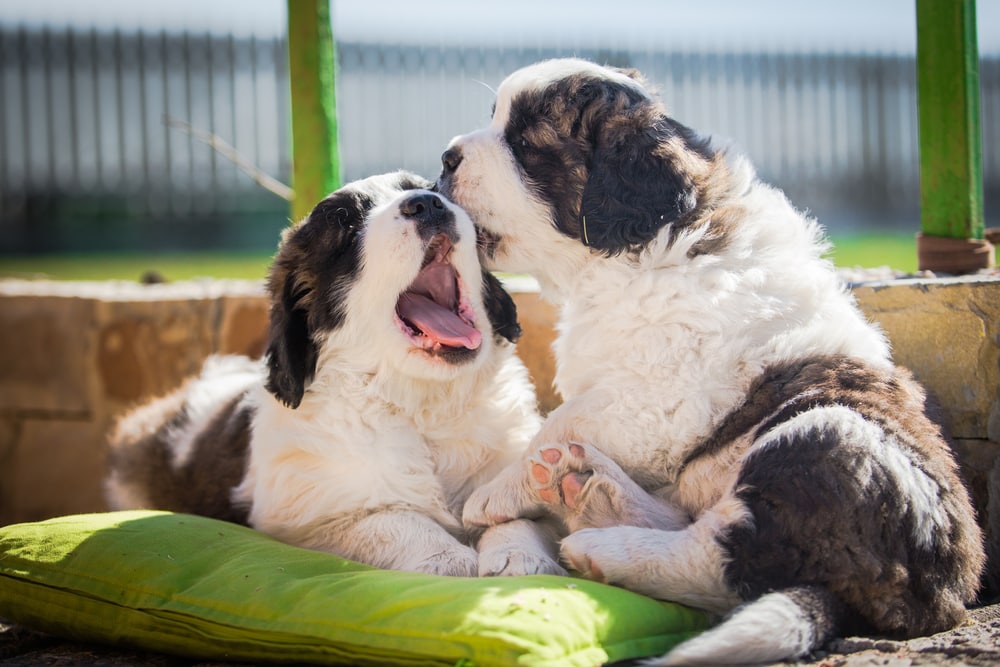Click to Skip Ahead
90’s kids immediately associate the St. Bernard with Beethoven, the children’s movie that caused a temporary spike in the breed’s popularity. But just what color was Beethoven? With nine possible coat colors registered with the American Kennel Club, the Saint Bernard has many different combinations to choose from and it can be hard to tell them apart. In fact, purebred Saint Bernards are never solid colored, but always have a pattern with shades of white, red, orange, or brown. They also typically wear their characteristic black mask on their face, but it isn’t required in the breed standard.
The 9 St. Bernard Colors & Patterns
Like dogs of all breeds, there are many more possibilities for personalities than there are for appearances. Overall, though, the Saint Bernard tends to be an amiable gentle giant with a knack for children and an easygoing nature that endears them to many. While the pattern of their coat seems to stay relatively similar across all Bernards, the color variations is what truly set each dog apart.
1. Brown & White
With a primary color between beige and chocolate, the brown and white St. Bernard has a coat that’s completely devoid of red hues. They aren’t the most common variety, but they may have been depicted by Darling’s dog, Nana, in the Disney cartoon Peter Pan.
2. Mahogany & White

Imagine having a dog with a coat that’s the color of an antique wardrobe. This rich hue is even more stunning on St. Bernard than it is on a piece of furniture.
3. Orange & White
A predominantly orange Saint Bernard is fairly common, especially with a black mask. An orange Saint Bernard takes on a more natural pumpkin color than red, rust, or mahogany colors.
4. Red & White
The highly saturated red color that dominates this coat pattern resembles red hair in humans.
5. Brindle & White

We don’t see this pattern often enough. Startlingly beautiful tiger stripes of red, black, and rust create the brindle variation. These Saint Bernards may also be “grizzled,” which means there’s no discernible pattern.
6. Rust & White
Rust lies in between shades of brown and red, but is most closely related to mahogany. From a distance, it can be hard to tell them apart. Rust shows more golden hues though than mahogany, which is closer to brown.
7. White & Brown
These beautiful dogs have more white fur than brown. This combination doesn’t have any red tint that’s commonly found in the breed, which sets this pattern apart.
8. White & Orange

The white and orange St. Bernard has orange patches that are more akin to carrots than a flaming reddish sunset found in the white and red coat.
9. White & Red

The color red is so vibrant on the St. Bernard, but this coat variation really pops with small patches of the bold color. This color combination looks very similar to a Brittany Spaniel.
All About Saint Bernards
These gentle giants were originally raised in the Swiss Alps as search and rescue dogs who pulled people out of the crushing snow after avalanches. In fact, they derived their name from the Great St. Bernard Hospice near St. Bernard Pass, the treacherous terrain where hikers would become trapped. Like so many places in the Italian region, these things—and the breed—were ultimately named after the Archdeacon of Acosta, Bernard de Menthon, who founded the hospice during the 11th century. The hospice was created to be a safe place for travelers going through the St. Bernard Pass, and the hospice was known to have dogs at least by the 1600s.
Typically weighing between 120 and 180 pounds, the Saint Bernard dog was up to the challenge of rescuing people. Some Saint Bernards, such as Kris who starred in the first couple of Beethoven movies, can even weigh 200 pounds or more.
As large dogs, their life expectancy tends to be shorter on average than small breeds. You can expect a Saint Bernard to have a lifespan between 8 and 10 years. These dogs are at higher risk of bloat and gastric torsion, where their stomach expands and twists due to being larger with a deep chest cavity. Immediate veterinary intervention can sometimes save their life. There are also precautionary steps you can take to reduce their risk of developing gastric torsion. Feed them a couple of smaller meals a day instead of one giant feast and wait at least an hour after they eat before engaging them in strenuous physical activity such as running or swimming.
St. Bernards are considered to have low to moderate energy levels. They only need about 30 minutes to an hour a day of exercise, such as running or going for a walk. However, preventing obesity is especially critical for large breeds because extra pounds put undue weight on their joints. Feeding a well-balanced diet and making sure they stay active are some of the best things you can do to ensure your St. Bernard lives a long and happy life.
Is a St. Bernard The Right Dog for You?

| Height: | 26–30 inches |
| Weight: | 120–180 pounds |
| Life Expectancy: | 8–10 years |
Loyal, easygoing, and eager to please, the Saint Bernard is the perfect family dog. They’re patient and even-tempered animals that aren’t likely to become aggressive. However, socialization training is always important from an early age to make sure they get along with other people and pets.
Due to their large size, you should make sure you have enough room for a St. Bernard in your home. They aren’t considered high-energy dogs, so apartment living isn’t out of the question as long as they have enough space. Other considerations include shedding and their tendency to drool. As long as you’re willing to brush them a couple of times a week—and keep a lint roller and towel on hand—you should be good to go.
Conclusion
Whether you adopt a red and white, a white and red, or one of the many other color combinations, the St. Bernard is sure to charm you. While they’re easily recognizable with their coat patterns and black mask, they’re also known for their winning personalities and love for their family.
See also:
- Akita Samoyed Mixed Dog Breed: Care, Pictures, Info, & More
- Akita Collie Mixed Dog Breed: Care, Pictures, Info, & More
Featured Image Credit: Rita_Kochmarjova, Shutterstock












